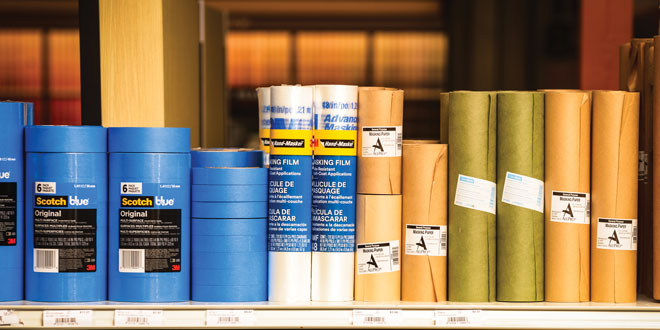Spending hours agonizing over paint chips and sample colors is a rite of passage for many painters. In addition to coaching your customers through the color selection process, your employees should also be able to assist them in choosing the right prep tools to achieve a professional, clean and quality finished product. It’s especially important when working with retail customers, because they may not understand the scope of products needed to successfully complete a project.
Helping customers pick the right paint prep products—like painter’s tape, masking tape and dropcloths—includes arming your employees with information on each product you sell and training them to ask questions, educate and inform.
Ask the Right Questions
The first step to selling prep items like painter’s tape, masking tape and dropcloths is figuring out the scope of the customer’s project so the employee can recommend the right products.
Nathanael Woody, regional manager for Spectrum Paint, says the company trains its employees to start by asking the right questions.
“The key to training your employees on selling anything is asking the right questions,” says Woody. “When it comes to painting projects, teach your employees to ask customers about their expectations for the project, their time frame and their budget so they can make informed recommendations.”
Once your employee has a grasp of the customer’s project, they can educate them on each product’s purpose and why it’s important for the job they want to do.
The painting prep category includes a wide variety of products, each with its own purpose and features. Eric Munoz, manager of Catalina Paints in Van Nuys, California, says his company
works to educate employees about the variety of items available in its stores so they can better service customers.
“We start by following manufacturers’ recommendations, but have also accrued a wealth of knowledge by listening to our customer’s feedback,” says Munoz. “We pass that knowledge on to our customers when given the opportunity.”
Taking the time to ask questions and provide helpful information goes a long way to building trust with customers. Spectrum Paint trains all of its employees to educate customers on the different products and not just immediately try to sell them the most expensive one.
“Our customers appreciate the information we are able to give them. Most of the time, once they understand why a product is important to the job they’re doing, they’re more likely to purchase it,” Woody says. “But sometimes they just want to spend as little as possible, and that’s fine too.”
The employees at Spectrum Paint also work to change perceptions. They see a lot of customers who think an old sheet works just as well as a dropcloth and don’t realize that dropcloths come in different varieties for different paint jobs.
“No one expects for the kids or pets to run in and knock over the bucket or drips to leak through the dropcloth, but it happens more than you can imagine,” says Woody. “We stress to the customer that having the right protection on the floor and covering furniture can eliminate a lot of cleanup.”
Use Merchandising to Educate
Employees who can educate your customers directly is just one avenue to making sure a customer leaves the store prepared for their project. You can also use other means like merchandising, signage, social media, blogs and advertising to let customers know about prep products and why they should purchase them.
Catalina Paints utilizes merchandising to highlight certain products. Munoz displays each prep product in its own section with the tape placed just inside the entrance on a highly visible endcap to grab the customers’ attention.
“The tape is the first thing customers see as they come in and the last thing before they leave our stores,” he says. “We also have a ‘painting checklist’ next to the checkout with a list of high-demand products that customers frequently forget.”
The company also takes advantage of its online store to educate customers on different products and bring in additional business. Each paint prep item in the online store has a detailed description and photos.
Catalina Paints’ marketing team discovered that painting prep items are a common Google search, and having these items on their website has driven traffic to the site, and ultimately, to the store.
“We’ve had customers purchase online from us after finding us on a Google search,” says Munoz. “We are finding that these are customers who wouldn’t have visited or purchased from us to begin with.”
Share Knowledge Creatively
Spectrum Paint also uses online tactics to educate customers, especially DIY customers, about painting prep products through a resources section on its website.
Gentry Stafford, vice president of marketing and store development for Spectrum Paint, along with the company’s marketing team, puts together the resources section using store professionals, professional painters and product manufacturers as sources.
The posts provide customers with helpful information on how to use the different painting prep products. Posts also cover other painting products.
One of the posts explains back-caulking, a technique Stafford chose to highlight because it is a method a lot of professional painters use, but many homeowners don’t know about. It’s just one example of how Spectrum educates customers, while also encouraging add-on sales in paint prep products.
“We want the customer to get knowledge and expertise, not just products, whether they are visiting the store physically or shopping our online e-commerce site,” she says. “We want to educate them so that hopefully they leave with us having solved any problems related to their painting project.”
Painter’s Tape 101
Masking tape is the least expensive option. It also provides the least amount of protection when painting. Masking tape can leave behind residue, especially if it’s left up for too long. Contractors use masking tape because it’s an inexpensive option for the amount of tape they use and they typically don’t leave tape up for long periods.
Safe-release tape doesn’t leave a residue. Most painter’s tapes are safe-release. This type of tape is effective on most surfaces and also provides protection against bleed through. Some manufacturers offer an ultra-sharp lines version, which is a thinner tape that gives an even cleaner line than the safe-release type. Delicate-surface tape works on multiple surfaces. This type is the best option for painting several surfaces in a room at one time. Most painters don’t realize that paint takes almost 30 days to fully cure; it dries to the touch in hours, but isn’t fully hardened for nearly four weeks.
Delicate-surface tape is ideal to use on paint that hasn’t fully cured. For example, if you’re painting an accent wall and want to paint one color soon after the other, the delicate-surface tape would be the best option to get a clean line and not pull up the first color.
“The delicate-surface tape is for those times you have multiple surfaces in a room like accent walls and trim and you want to knock it out in one weekend,” says Woody.
Creative Uses for Dropcloths
While your primary customer base will use dropcloths for their intended purpose, there may be inspiration beyond only protecting from messes. Check out these fun projects to make with dropcloths for ideas on creatively merchandising them in the store. Search online for craft blogs and lifestyle websites for other ideas to suggest or even create and display on your salesfloor.
- Curtains
- Tablecloth
- Table runner
- Pillow
- Wreath
- Storage bin
- Gift Wrapping
- Bunting
- Christmas tree skirt
- Rug







